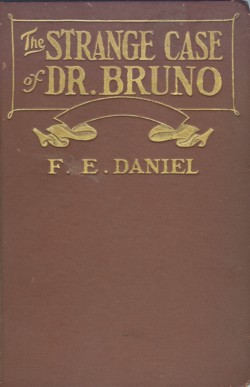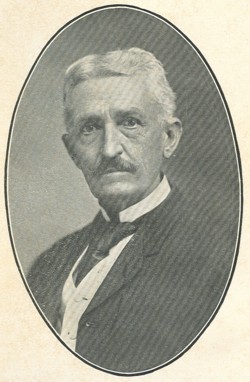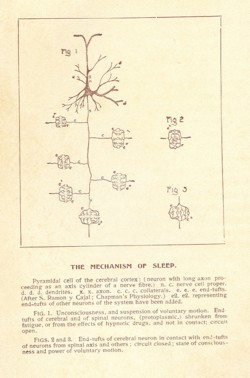|
F.E. Daniel's The Strange Case of Dr. Bruno (Von Boeckmann-Jones; 1906; 235 pp.; illus.; original price $1.50) is something of a rarity. Daniel's novel is an early work of science fiction. In addition, Daniel was an Austin, Texas doctor who used his medical background to lend his tale of suspended animation veracity.
|
Daniel (1839 - 1914) was born in Virginia and educated in Vicksburg, Mississippi before turning to the study of medicine in Jackson. Enlistment as a Private in the Confederate army in 1861 -- he was at the Battle of Bull Run -- halted his progress until Confederate President Davis ordered all young men studying medicine out of service. Daniel completed his medical education in New Orleans and returned to service as a surgeon with the rank of Major. He served in several battles and was in charge of running many hospitals. Daniel later wrote a book about his experiences titled Recollections of a Rebel Surgeon (1899).
After the war, Daniel spent time in various Texas cities like Galveston, Sherman and Fort Worth before finally settling down in Austin, the state capital. In the medical field his accomplishments include founding two Texas medical journals, acting as President of the Texas Quarantine Department, and serving as President of the American International Congress on Tuberculosis. Daniel was also a man of letters. Besides his two books he wrote papers and gave lectures such as "Castration of Sexual Perverts" (1893), "Crime and Pauperism" (1897), and "Criminal Responsibility of the Insane" (1898) among others.
| 
|
Daniel was married three times and twice widowed. His second wife bore him six children. Much of the doctor's personal and professional background comes into play in this novel.
The Strange Case of Dr. Bruno is written in a manner popular from at least the early 19th Century, the story related through journals, diaries and letters, perhaps to better convince the reader of the tales' reality. In this case, events are described in the papers of one Dr. Courtenay, said papers having passed to his cousin, the editor, upon his death. Dr. Courtenay's manuscript lays out the strange case of his friend Dr. Frederick Bruno, a young American student from Vicksburg, Mississippi (in the formal language of the day "the place of my own Nativity") he met while studying at Heidelberg in the last quarter of the 1800s.
Bruno is described as handsome, well groomed and sociable, although he avoids the company of ladies and refuses their invitations because he wishes to avoid entanglements. In this early stage the novel reminds somewhat of Poe, a feeling of foreboding and secrecy shrouds the proceedings. This atmosphere also overlaps into Lovecraftian territory, the sense that secrets beyond the ken of human understanding are about to unfold is strong. But it is all dashed quickly as the concerns of Daniel come to the forefront.
 |
Periodically, throughout the novel, Daniel uses his pen to declaim those issues close to his heart and mind. Early in the story we learn that Bruno is seeking his "affinity," that is, the one girl of his dreams, someone who today we might refer to as a soul mate. Here Daniel takes the opportunity to declare, through the character Bruno, that the "mission of my sex [is to] found a home and rear a family." Bruno/Daniel is bothered by a societal double standard for women.
Before this can be mistaken for early feminism, Bruno goes on to elaborate that women should not be kept ignorant of the secrets of procreation because of "mistaken notions of propriety and false delicacy." He believes that mothers should be responsible for the sexual education of their daughters and "these things which so nearly touch their mission on earth." These things are to have children and make a home for them and a husband.
Also quite early in the book Daniel gives a few pages over to Bruno in expressing his thoughts on how he would approach the popular novel, should he ever write one. He promises that it would not tread the beaten path, have no hero, heroine or villains. Nor would there be duels, shipwrecks or storms. He wouldn't bother to describe the beauty of the female characters as what is beautiful to one reader is not to another.
He says that he would never have his male character fall sick and linger on death?s door for days or weeks on end only to be nursed back to health by the romantic interest. And if he did do that, he?d let the male die, if only to disappoint the reader. And to further confound everyone, he?d have the girl marry the other fellow. As we shall see, it seems that Daniel was forewarning his own readers not to expect the typical romance to which they were accustomed. Unfortunately, he did not promise to eliminate melodrama and a heavy use of improbable coincidences.
|
We leap ahead a few years and Bruno has returned to America and settled in Jackson, Mississippi. Now it is revealed that he is actually Baron Frederick von Bruno, an adopted child, and independently wealthy. He has fallen in love with Katie Kardelle and his attentions seem to be favored by Katie?s father. But there is a rival, Harold Ogden, tall, handsome and blonde, but who works for a living, an orphan raised by a black family.
But something goes wrong in the courtship and Bruno next shows up in New Orleans where he is taken in by his friend Dr. Courtenay. Bruno remains a recluse, preferring the company of only Courtenay and a general practitioner, Dr. Rickard.
Their intellectual discussions give Daniel the opportunity to speculate on crime and criminality. He notes the increase of crime in the U.S. and blames environment as the factor that most influences the creation of a criminal. He proposes that death by injection would be the most humane method of execution. He also proposes that the criminal?s dead body be used in some manner that would be useful to society -- either as fuel or fertilizer.
He believes that criminals could allow their bodies to be operated on in the the service of science and medicine. They could be anesthetized in a manner that would allow them to follow and comment upon the surgical proceedings, or they could be rendered unconscious. He would like to use criminals to see if a man could be put into a state of hibernation. He cautions his listeners that should they ever find him in such a state, they should not let him sit up upon awakening, no matter what, as the heart will be weak and he could have a massive coronary. This provides the segue to the core of Bruno?s strange case and his desire to induce a state of suspended animation in a human.
So it is that one morning Bruno is reported dead by a manservant. Closer examination reveals that Bruno is breathing but his pulse almost non-existent and his body temperature a mere 80 degrees. A note explains that all is well, that he should be left alone for six months and twelve hours.
A manuscript by Bruno provides more information, filling in Bruno's background, detailing the events of his courtship with Katie and why he suddenly turned up in New Orleans. This is also the point at which the melodrama and coincidences are piled one upon another in a staggering test of a reader's tolerance for implausibility.
As stated earlier, Katie?s father, Mr. Kardelle favors a match between his daughter and Bruno. That is until he learns that Bruno is actually from Vicksburg. The young child was orphaned when Northern troops attacked the city. Subsequently, Bruno was adopted by his foster father. Kardelle seems to have some knowledge of the events surrounding the situation and becomes cool, although civil, to Bruno.
One evening, Bruno and Katie are out driving in the countryside. "Driving" then meant in horse and buggy. Through gestures and speech Bruno realizes that he has won over Katie and that she will consent to be his wife. On the road back they encounter the romantic rival Ogden. Bruno's high spirits inform Ogden that Katie has chosen the Baron.
Ogden pulls a pistol and challenges Bruno. Bruno uses his own pistol and wounds Odgen in the arm. In the ensuing days, Bruno frequently sees Ogden riding with Mr. Kardelle and realizes that his favor has been transferred.
When Bruno announces to Mr. Kardelle that he intends to marry Katie the older man says he cannot give his consent. "It would be your ruin," he says and "would break [Katie's] heart and yours." But more he will not say. Despite his protest, Bruno and Katie elope to another city, then wire Kardelle of their actions. Kardelle arrives in town the next morning.
Kardelle tells the two a long story. He relates how he separated and sold his black female servant and her twelve year-old son in order to pay a drunken gambling debt. Afterwards, he was stricken with remorse, swore off alcohol, became a devout Catholic, married and had a son.
It should be mentioned here that Daniel uses racist terms in describing his black servants and characters. Statements such as "the ignorant and superstitious Negro!" are jarring and in bold relief, all the nastier for the casual matter-of-factness with which they are delivered.
Kardelle reveals that during the fighting in Vicksburg he witnessed the death of Bruno's blood father, Mr. Foncetti. At the same time, during the confusion in the city, Kardelle's son is kidnapped by Lucy Ogden‘ son. These were the two Kardelle separated and sold. This is Lucy's revenge. Harold Ogden, Katie's suitor, is really Kardelle's son.
Ogden leaves the country, unable to bear the love he holds for his sister. But Katie isn?t Ogden?s sister. Katie is Kardelle's adopted daughter. Katie is actually Bruno?s sister, saved from the rubble in Vicksburg, placed in an Ursuline Convent and identified by the name stitched on her clothing.
Upon learning this Bruno suffers a massive shock. The next thing he knows it?s a year later and he is a patient in a sanitarium under another name. He tries to pick up the pieces, returning home to learn that Kardelle is dead and Katie missing. Everyone, including Katie, thought him dead, waylaid by thieves. He searches the country for her but to no avail. Bruno returns to Germany where he makes the scientific discoveries that allow him to conduct his great experiment in suspended animation.
Bruno's theories consume page after page. He believes that all mental action, including all muscular and glandular action -- secretion and excretion -- a "specialized" force the result of oxygen acting on food consumed. He espouses an early doctrine of "you are what you eat." He compares the working of the human body to steam engines or a gas jet turned low. An engine can be put on standby be reducing the amount of fuel. He hopes to accomplish something like this with the human body in order to achieve "arrested animation."
A lot of time is spent trying to build a plausible medical explanation when a modern writer might likely just cut to the chase, assuming that the reader has suspended disbelief. Daniel used the time to espouse more hopes and dreams, predicting a national healthcare system, calling for ventilated and temperature regulated (air conditioned?) train cars, and asks that disease harboring red velvet upholstery and curtains be abolished from public transport. Further, he hopes that trains will be bigger and better appointed, with more privacy, and run on electricity produced by Niagra Falls or the sea tides. He predicts that coal will be supplanted by electricity, air navigation will become an established industry, and telegraphs and telephones will become wireless. Not bad for a doctor standing at the beginning of such technological breakthroughs.
One reason to be placed in suspended animation would be to witness these marvels. The author was 67 at the time and may have been concerned with his own mortality. He'd survived a devastating war, lost a wife to a yellow fever epidemic, and, in his function as a doctor, seen much suffering and death. One benefit to suspended animation not mentioned is that a sick or dying person could be revived at a later date when a cure for their malady was discovered.
| Ten or more pages are spent on a lengthy explanation of how Bruno divined to use a diluted and synthetic version of wasp venom. His experiments with this liquid consumed several years as he tested it on various animals, eventually working his way up to a chimpanzee which he was able to successfully put to sleep and revive several times. Here Bruno's manuscript ends and we return to Dr. Courtenay's account of events.
As Bruno lies dormant more improbably story and character coincidences swirl around him. Harold Ogden, now a wealthy sugar planter, shows up in New Orleans with yellow fever, his presence coming to Dr. Rickard's attention when the physician is called to attend him. Odgen has fallen in love with Rickard?s beautiful nurse, Katie. If you have followed all the twists so far then you won't be surprised to learn that Katie is Bruno's daughter, conceived on that one night he shared with his wife, Katie. And she?s the spitting image of her mother, now deceased.
Now we learn more details that threaten to pull this story to pieces, if it hasn't already come apart at the seams. Katie?s mother wasn't really found in the rubble of Vicksburg. She was already in the Ursuline Convent. The girl found in the rubble, Katie Foncetti, along with her clothing, were brought to the convent. The child died and her clothes given to Katie's mother. When Kardelle adopted her he assumed that she was Katie Foncetti since that was the name stitched on her clothing. So, Katie, the elder, really isn't Bruno's sister after all. |
 |
Katie, the younger, learns all this and wishes to be at her father?s bedside when he awakens. This course of action would seem ill-advised to anyone giving it even a moment?s thought, but Courtenay and Rickard consent. Predictably, when Bruno awakes, he sees his daughter, mistakes her for his wife, sits up suddenly with outstretched arms -- and promptly dies of a massive coronary.
Although in love with Ogden, Katie is pledged to Dr. Rickard. The nurse honors her commitment and Ogden is never seen or heard from again. Daniel concludes, finding merit in a novel that doesn't end happily. He considers a happy ending a hoary convention of fiction and cites Mary Johnston?s (she was a popular novelist from 1898 to 1932) Prisoners of Hope (1898) as the only novel he can name that ends unhappily. Well, readers can?t say that Daniel didn't warn them.
The Strange Case of Dr. Bruno, despite many good notices upon publication, especially in the medical community, has, perhaps understandably, gone out of print. It appears somewhat difficult to get, Abebooks showing only four copies available at prices ranging from about $20.00 to a little over $50.00. To a science fiction completist, a collector of Texana, an aficionado of curios, or a student of early 20th century literature The Strange Case of Dr. Bruno may hold some interest. To all others it would seem to be of little use or entertainment value.
|









